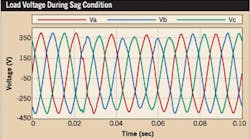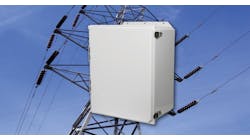Learning to Read Waveform Signatures
Editor's note: This article was first featured in the February 2003 issue of EC&M. It has been updated to reflect newer power quality instruments and updated standards.
Today, many facilities have online monitoring systems that continuously track power quality, provide valuable information about energy use, and characterize harmonic distortion levels. These systems can even be set up to “trigger” on specific disturbances associated with equipment misoperation. Sorting through the mountain of data produced by these systems, however, is a difficult task. Even if you only have monitoring equipment set up at the service entrance, the amount of information to sift through can be staggering.
PQ measurement tools
Today's modern intelligent monitoring systems employ a variety of different technologies, such as signal processing, knowledge-based techniques, and data mining, to evaluate the large quantity of collected measurement data and to identify conditions of concern. They continually process the data and produce an alarm or notification when a condition occurs that warrants further investigation or action.
In addition, manufacturers of modern power quality monitoring instruments have developed expert systems that look through significant amounts of monitoring data and identify particular events and conditions. One major cause of concern would be the indication of an equipment problem or incipient failure. However, it's only possible to look for abnormal conditions after these expert systems characterize the waveforms associated with normal operation of facilities and equipment. Here's where you can use a facility's typical waveforms or profiles to help in identifying the abnormal conditions that can affect normal operation of equipment. Even with all these state-of-the-art test and measurement devices, you still must have the skills to interpret the various waveform signatures captured and stored by the monitoring system.
Most equipment and facilities have a typical load profile or waveform signature that defines the range of current magnitudes and power levels associated with normal operation. Values outside these normal characteristics can indicate a fault condition, an abnormal load condition, or some other type of system problem. Let's take a look at some examples to help you get started on your path to becoming a PQ signature expert.
Response of motor loads to unbalanced voltage sags
Voltage sags caused by faults on the supply system are detrimental to the safety and normal operation of industrial processes. These short voltage variations can cause sensitive loads and controllers to trip offline, affecting the entire production process. Voltage sags can even affect conventional induction motors.
Figure 1A on page 30 shows the response of a motor load during a voltage sag condition caused by a single line-to-ground fault on the supply system. In Fig. 1B on page 30, note the severe unbalance in the current caused by the unbalanced voltages during the sag condition. This can cause negative sequence relays to operate. In some cases, the high currents following the sag can trip motors on overcurrent.
Capacitor switching transients and adjustable-speed drives (ASDs)
Certain normal conditions occur periodically — usually in the utility system external to a facility, but sometimes within a facility — and can have adverse effects. One of them is capacitor switching, which causes transient overvoltages that can affect a variety of loads in a facility. It can cause electronic ballasts in fluorescent lights to fail and fuses in local power factor correction systems to blow. It may even force small surge suppressors to work overtime.
ASDs experience the most acute effects. An Electric Power Research Institute (EPRI) brief, “Power Quality Considerations for Adjustable Speed Drives,” explains one common adverse condition. Because the internal DC link capacitor is essentially connected alternately across each of the three phases, drives of this type can be extremely sensitive to overvoltages on the AC power side. One event of particular concern is capacitor switching on the utility system.
As an arc is drawn switching the capacitor bank, it excites an LC ring wave at the natural frequency of the inductance of the system and the bank capacitance. These utility-generated voltage-switching transients result in a surge of current into the DC link capacitor at a relatively low frequency (300 Hz to 800 Hz). This current surge charges the DC link capacitor and causes an overvoltage to occur. The overvoltage, though not necessarily magnified, exceeds the voltage tolerance thresholds associated with the overvoltage protection, properly tripping the ASD out of service. This is called nuisance tripping because the situation can occur day after day — often at the same time of day.
Several methods are available to resolve such tripping, some of which are simple and others that are costly. Although it's a relatively expensive alternative, the use of a harmonic filter to reduce overvoltages is very effective in protecting drives from component failure but may not completely eliminate nuisance tripping of small drives. For example, simply switching utility company 69kV circuit breakers several miles away can result in a relatively high-frequency ring wave that can cause internal drive under/overvoltage tripping. The built-in protective functions offered by some manufacturers may be peak-sensing rather than rms-sensing. Therefore, the protection senses an instantaneous under/overvoltage condition, assumes it's an rms condition, and erroneously trips the ASD off-line.
The most effective, and relatively inexpensive, way to eliminate nuisance tripping of small drives is to isolate them from the power system by adding commutating reactance in the primary of the drive. Sometimes, the addition of an appropriate UL 1449 2nd Edition transient voltage surge suppressor (TVSS) is also warranted.
Figure 2A shows a typical capacitor switching transient caused by a switching operation on the supply system. Figure 2B depicts the response in the load current.
DC drives and voltage notching
The term “notching” describes the distortion of the voltage waveform of DC drives and other loads with phase-controlled rectifiers due to the current in the drive converter commutating from one phase to another. This commutation is actually one set of thyristors or diodes turning off and another turning on. It occurs when thyristors are used.
In a full 6-pulse converter, the thyristors operate in pairs to convert AC to DC by switching the load current among the six thyristor pairs six times per AC cycle. During this process, the current begins to transfer from one phase to the next, creating a momentary phase-to-phase short circuit. Source inductive reactance prevents instantaneous transfer (commutation), resulting in a commutating notch. The duration of this short circuit is a function of the total system inductance and the DC output current. The notch depth and area will differ, depending on where in the system they are measured.
These notches in the voltage waveform can cause interference with other loads in a facility. For example, resistor/capacitor (snubber) networks will begin to discharge and charge during commutation notches, because a line notch is a sudden change in voltage. Where multiple drives are applied on a common bus, the composite commutation notching can overwork these snubber circuits and, in severe cases, cause them to fail catastrophically. These networks are applied to absorb transient voltages occurring across the thyristors due to high-speed electronic switching. If these networks are out of tolerance or nonfunctional, a transient voltage overshoot may occur with a high incidence of thyristor fuse blowing and/or drive component failures. Other sensitive equipment fed from the common system can also exhibit power quality/control problems. These oscillations can also cause misoperation of clocks and controls within a facility.
IEEE 597-1983, “Standard Practice and Requirements for General Purpose Thyristor DC Drives,” gives a practical upper limit by requiring that repetitive peak deviations of the fundamental line voltage from the instantaneous value of the line voltage not exceed 25% of the crest working line voltage. (Note: Although reaffirmed in 1991, IEEE 597 was later withdrawn and exists today as nothing more than a historical reference.)
These line notches are also rich in high-frequency harmonics and are propagated throughout the power system. Sensitive electronic equipment, such as computers, programmable logic controllers (PLCs), and instrumentation, are especially sensitive to the high-frequency content caused by line notching. For this reason, it's always a good idea to keep these sensitive-type loads electrically isolated from these drives.
Line notching can also cause thyristor misfiring. This can happen when notch width exceeds gate pulse width or with excessive notch depth. Per IEEE 519-1992, “Recommended Practices and Requirements for Harmonic Control in Electrical Power Systems,” ASDs should be selected and designed to operate with notch widths of 250 microseconds and a depth of 70% of rated peak line current or less.
Figure 3A shows a typical condition of severe notching of the voltage waveform caused by a DC drive. Figure 3B shows the currents of the DC drive. Note the load current variations as the firing angles are varied.
Power factor correction and harmonic resonance
Many industrial loads have relatively low power factor, inviting fines from power companies. Power factor correction capacitors can compensate for these loads and generate significant savings on electric bills. However, these capacitors can cause harmonic resonance problems, especially if the facility includes nonlinear loads like variable-frequency drives (VFDs).
Operating AC VFDs with thyristor converters at slow speeds generally results in poor power factor. If the number of AC drives is small compared with overall plant load, then the total power factor at the utility metering point may not be cause for concern. However, large systems of VFDs would require reactive compensation.
One characteristic of pulse-width modulated (PWM)-type VFDs is a good power factor due to a diode's front end design. Where lots of smaller drives are applied with expected low-speed operation, PWM-type drives will significantly improve power factor and could reduce the cost of harmonic filtered capacitor banks.
Installing and switching a capacitor with a motor isn't recommended with AC drives. If the supply transformer and capacitor create a resonance frequency that is the same as a harmonic produced by the drive, high-harmonic voltage and current magnitudes can occur at the capacitor, which may cause fuse melting or component failure. A safer application, from a harmonic viewpoint, is to install the properly rated shunt capacitor with a series tuning reactor at the high-voltage circuit.
Figure 4A shows an example of a resonance problem excited by power factor correction capacitors. Figure 4B shows a harmonic spectrum for the voltage waveform (Phase A) shown in Fig. 4A. Note the high fifth and seventh harmonic components, between which the resonance is present.
Other examples
Monitoring systems can also recognize and track several other conditions, including:
-
Operation of overcurrent protection equipment and identification of coordination problems;
-
Motor starting inrush currents that cause protective device operation;
-
Unbalanced voltages that can cause motor heating or operation of negative sequence protection;
-
Neutral conductor overload and heating caused by third harmonic components from electronic equipment;
-
Derating requirements for transformers caused by harmonic loading;
-
Interaction of loads during switching operations within the facility, such as transformer inrush, motor inrush, and transient voltages; and
-
Response of electronic ballasts to transients.
Looking at the results
The first step to becoming an expert in waveform analysis is to understand the normal operational conditions of your system. Although these characteristics can vary from facility to facility, some features are typical in several conditions and operations.
The next step is to recognize and decipher the waveform signatures that are captured by an expert monitoring system. Power signature books, available from power monitoring systems manufacturers, list identifying features, causes, symptoms, and solutions along with the respective signature waveform of the abnormal condition. Almost all of these books emphasize that before you begin analyzing a waveform signature, you should ask the following questions:
-
Who took the data?
-
Where was the monitoring done?
-
What was the reason for monitoring?
-
Has anything changed nearby?
-
What kinds of problems were experienced?
Only after obtaining answers to these questions should you look at the disturbance graph and begin your analysis. With a little practice, you'll soon be able to match a waveform signature to a power disturbance just like a handwriting expert matches a signature to a person.
McGranaghan is vice president of consulting services for EPRI Solutions, Knoxville, Tenn. He can be reached at [email protected].



